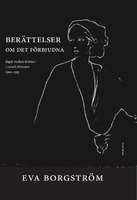Berättelser om det förbjudna: Begär mellan kvinnor i svensk litteratur 1900–1935
Contributor(s)
Borgström, Eva (editor)
Language
SwedishAbstract
"Same-sex love was forbidden by law until 1944, and in culture it continued to be taboo, but it has always existed there. The prohibition created tensions which art and literature could play with. Narratives about forbidden love show this through well-known authors such as Agnes von Krusenstjerna, Maria Sandel, Karin Boye and Frida Stéenhoff, and less well-known ones like Gertrud Almqvist, Margareta Suber, Lydia Wahlström and the pseudonym Elsa Gille. The book investigates literary narratives about women’s love for women and the ideas about the forbidden contained in them. What strategies did the authors use to get round the ban on the mention of the topic? Are there any utopian visions of how everything could be arranged in a different and better way? And how does the literature relate to other theories about same-sex love? Berättelser om det förbjudna: Begär mellan kvinnor i svensk litteratur 1900–1935 (“Stories of the Forbidden: Desire between Women in Swedish Literature 1900–1935”) is a free-standing continuation of Kärlekshistoria: Begär mellan kvinnor i 1800-talets litteratur (“Love Story: Desire between Women in Nineteenth-century Literature”, 2008). Together the books span over 100 years of Swedish literary history, making them the most comprehensive study available in the field in Sweden and Scandinavia.
Eva Borgström is associate professor of comparative literature and lecturer at the Department of Literature, History of Ideas, and Religion at the University of Gothenburg. She has formerly worked at the National Secretariat for Gender Research and the Department of Gender Studies. Samkönad kärlek var fram till 1944 förbjuden enligt lag och i kulturen var den tabuerad längre än så, men den har ändå alltid funnits där. Förbudet skapade spänningar som konsten och litteraturen kunde spela med. Berättelser om det förbjudna visar detta genom välkända författare som Agnes von Krusenstjerna, Maria Sandel, Karin Boye och Frida Stéenhoff, liksom mindre kända som Gertrud Almqvist, Margareta Suber, Lydia Wahlström och pseudonymen Elsa Gille. Boken undersöker skönlitterära berättelser om kvinnors kärlek till kvinnor och de föreställningar om det förbjudna som finns i dem. Vilka strategier använde författarna för att komma runt yttrandeförbudet? Finns det några utopier om hur allt skulle kunna ordnas på ett annat och bättre sätt? Och hur förhåller sig litteraturen till andra teorier i tiden om samkönad kärlek? Berättelser om det förbjudna. Begär mellan kvinnor i svensk litteratur 1900–1935 är en fristående fortsättning på Kärlekshistoria. Begär mellan kvinnor i 1800-talets litteratur (2008). Tillsammans spänner böckerna över 100 år av svensk litteraturhistoria och utgör därmed den hittills mest omfattande studie på området som finns i Sverige och Norden.
Eva Borgström är docent i litteraturvetenskap och lektor vid Institutionen för litteratur, idéhistoria och religion vid Göteborgs universitet. Tidigare har hon bland annat arbetat på Nationella sekretariatet för genusforskning och Institutionen för genusvetenskap. "
Keywords
women's rights; karin boye; swedish literature; maria sandel; frida stéenhof; agnes von krusenstjerna; sexology; lesbian studies; gertrud almqvist; margareta suber; lydia wahlström; elsa gilleDOI
10.22188/kriterium.3ISBN
9789170616976OCN
1030821753Publisher
KriteriumPublication date and place
Gothenburg, Sweden, 2016Classification
Literature: history and criticism
Gender studies, gender groups


 Download
Download Web Shop
Web Shop